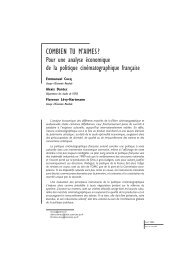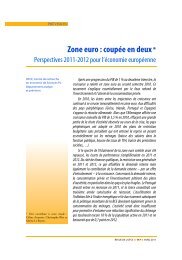direct multi-step estimation and forecasting - OFCE - Sciences Po
direct multi-step estimation and forecasting - OFCE - Sciences Po
direct multi-step estimation and forecasting - OFCE - Sciences Po
You also want an ePaper? Increase the reach of your titles
YUMPU automatically turns print PDFs into web optimized ePapers that Google loves.
Direct <strong>multi</strong>-<strong>step</strong> <strong>estimation</strong> <strong>and</strong> <strong>forecasting</strong><br />
Abstract<br />
This paper surveys the literature on <strong>multi</strong>-<strong>step</strong> <strong>forecasting</strong> when the model or the <strong>estimation</strong> method<br />
focuses <strong>direct</strong>ly on the link between the forecast origin <strong>and</strong> the horizon of interest. Among diverse<br />
contributions, we show how the current consensual concepts have emerged. We present an exhaustive<br />
review of the existing results, including a conclusive review of the circumstances favourable to<br />
<strong>direct</strong> <strong>multi</strong>-<strong>step</strong> <strong>forecasting</strong>, namely different forms of non-stationarity. We also provide a unifying<br />
framework which allows us to analyse the sources of forecast errors <strong>and</strong> hence of accuracy improvements<br />
from <strong>direct</strong> over iterated <strong>multi</strong>-<strong>step</strong> <strong>forecasting</strong>.<br />
Keywords: Multi-<strong>step</strong> Forecasting, Direct <strong>estimation</strong>, Varying Horizon, Structural breaks, Nonstationarity.<br />
Résumé<br />
Cet article constitue un exposé des développements concernant la prévision à horizon variable<br />
lorsque les modèles ou méthodes d’<strong>estimation</strong> visent <strong>direct</strong>ement le lien entre l’origine de la prévision<br />
et l’horizon considéré. Au sein des diverses contributions, nous montrons comment les concepts qui<br />
font actuellement consensus ont progressivement émergé. Nous présentons de manière exhaustive<br />
les résultats existants, en particulier concernant les circonstances favorables à l’usage de la méthode<br />
d’<strong>estimation</strong> <strong>direct</strong>e, à savoir différentes formes de non-stationnarité. Nous fournissons également<br />
un cadre unificateur qui permet d’analyser les différentes sources d’erreur de prévision, et ainsi<br />
d’amélioration de la précision de la prévision grâce à la méthode <strong>direct</strong>e (par opposition à l’itération<br />
de prévisions à horizon unitaire).<br />
Mots-Clef : Prévision à horizon variable, Estimation <strong>direct</strong>e, Multi-étapes, Chocs structurels, Nonstationnarité.<br />
2








